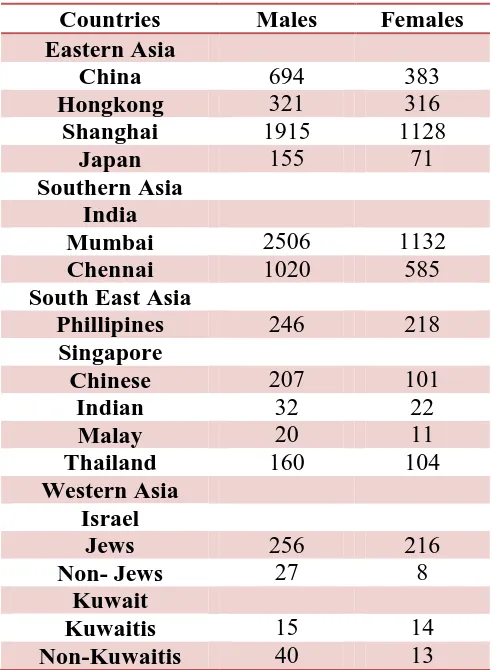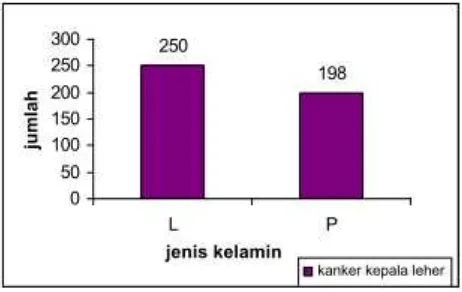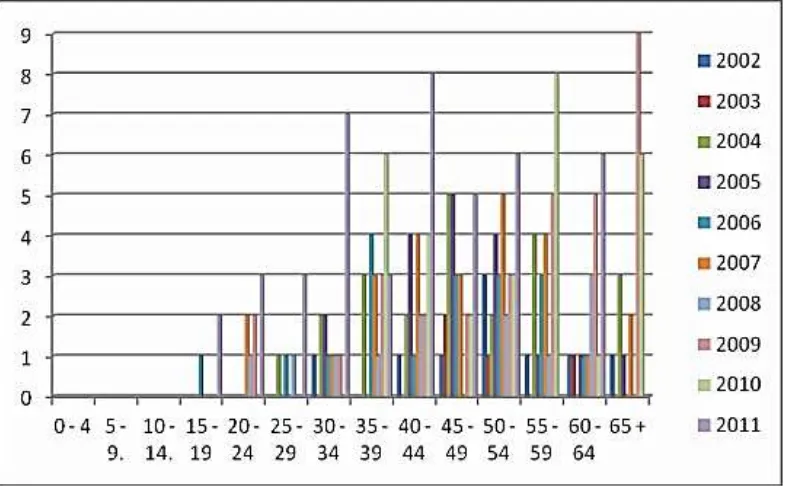CHAPTER II
LITERATURE REVIEWS
2.1 Definition of Head and Neck Cancer
Generally, cancer is the uncontrolled growth and spread of cells. It caused by the loss of differentiation and apoptotic ability in cells. It can affect almost any part of the body as a primary site of cancer. The growths often invade surrounding tissue and can metastasize to distant sites. The etiology of cancer is multifactorial; sometimes the specific cause is unknown. While, specifically, Head and Neck Cancer may be defined as the number of different malignant tumors that develop in head and neck regions. 6
2.2. The Types of Head and Neck Cancer
Head and Neck Cancer can be classified based on its anatomic sites, and also can be encoded based on ICD 10 Classification.7,8
2.2.1. Based on Its Anatomic Site7
1) Oral cavity
The anterior border is the junction of the skin and vermilion border of the lip. The posterior border is formed by the junction of the hard and soft palates superiorly, the circumvallate papillae inferiorly, and the anterior tonsillar pillars laterally. The various sites within the oral cavity include the lip, gingival, hard palate, buccal mucosa, floor of mouth, anterior 2/3 of tongue, and retromolar trigonum.
2) Oropharynx
The oropharynx includes the base of the tongue, the inferior surface of the soft palate and uvula, the anterior and posterior tonsillar pillars, the glossotonsillar sulci, the pharyngeal tonsils, and the lateral and posterior pharyngeal walls
3) Hypopharynx
The hypopharynx includes the pyriform sinuses, the lateral and posterior hypopharyngeal walls, and the postcricoid region.
4) Larynx
5) Nasopharynx
The nasopharynx, extends from the base of the skull to the upper surface of the soft palate. It includes the space between the internal nares and the soft palate and lies above the oral cavity. The adenoids, also known as the pharyngeal tonsils, are lymphoid tissue structures located in the posterior wall of the nasopharynx. Waldeyer's tonsillar ring is an annular arrangement of lymphoid tissue in both the nasopharynx and oropharynx.
6) Nasal Cavity and Paranasal Sinuses Cancer
The paranasal sinuses include the ethmoid, maxillary, sphenoid, and frontal sinuses.
The maxillary sinus is a pyramid-shaped cavity within the maxillary bone. The medial border is the lateral nasal wall. Superiorly, the sinus abuts the orbital floor and contains the infraorbital canal. The posterolateral wall is anterior to the infratemporal fossa and pterygopalatine fossa. The anterior wall is posterior to the facial skin and soft tissue. The floor of the maxillary antrum extends below the nasal cavity floor and is in close proximity to the hard palate and maxillary tooth roots.
ethmoid sinus is bound by a thin bone called the lamina papyracea, which separates it from the medial orbit. The posterior border of the ethmoid sinus is close to the optic canal. The anterosuperior border or roof of the ethmoid is formed by the fovea ethmoidalis, which separates it from the anterior cranial fossa. The perpendicular plate of the ethmoid bone separates the ethmoid cavity into left and right sides.
7) Salivary Glands Cancer
The salivary glands include the parotid, submandibular, sublingual, and minor salivary glands.7
2.2.2. Based on International Statistical Classification of Diseases and Related
Health Problems 10th (ICD 10)
The ICD 10 can be used to classify disease and health problems and is used to translate the disease from words into an alphanumeric code. Malignant neoplasms stated or presumed to be primary, of specified sites. Below are the classification code for neoplasms in head and neck region (for further classification, see the attachment)8:
2.3. Risk Factor of Head and Neck Cancer
A risk factor is something that increases the chance of developing cancer. But having a risk factor for cancer doesn’t mean that people will definitely get it. Some people with risk factors never develop cancer, and other people without any known risk factors can still develop it.
Below are some risk factors of Head and Neck Cancer.
1) Age
Almost study proved that people over 50 are at higher risk for head and neck cancer. Two main mechanisms have been suggested to explain the increase in cancer incidence with ageing: the first refers to prolonged exposure to carcinogens during life and the second explanation seems to be attributed to the individual vulnerability to cancer with age.9
2) Sex
2.4. Incidence of Head and Neck Cancer
Head and Neck cancer is a serious and growing problem in many parts of the world. Some epidemiological studies were conducted in some certain countries. According to the incidence data, Head and Neck Cancer showed different patterns each year.
The previous study about International Trends in Head and Neck Cancer during 1998- 2002 found the incidence of this cancer as follow. Data displayed is restricted to the incidence of cancer in Asian continent.4
Table 2. Head and Neck Cancer Incidence in Asia during 1998-2002
The epidemiological study before have been conducted at Kariadi Hospital Semarang Hospital, by Onggo Wiliyanto, found that there were 448 cases of Head and Neck Cancer during January 1st 2001 – December 31th 2005. The distribution based on sex can be seen as follows.5
Figure 1. The incidence of Head and Neck Cancer Based on Sex at Kariadi
Hospital Semarang Indonesia during January 1st 2001 – December 31th 2005 Cited from: Wiliyanto5
Based on the diagram above, men suffering Head and Neck Cancer were more than woman. There were 250 cases in men and 98 cases in women during five years period.
Figure 2. The Incidence of Head and Neck Cancer Based on Age at Kariadi
Hospital Semarang Indonesia during January 1st 2001 – December 31th 2005 Cited from: Wiliyanto5
Figure 3. The Incidence of Head and Neck Cancer Based on Anatomical
Pathology Diagnosis at Kariadi Hospital Semarang Indonesia during January 1st 2001 – December 31th 2005
In the same research, based on anatomical pathology diagnosis, nasopharyngeal cancer became the most Head and Neck Cancer incidence, as can be seen in the diagram above.
As the most cases in Head and Neck Cancer, there was previous study about the incidence of Nasopharyngeal Cancer at Kariadi Hospital Semarang Indonesia, brought by Merry Puspita. This study found the incidence of Nasopharyngeal Carcinoma based on age and sex between 2002 and 2011.10
Figure 4. The Incidence of Head and Neck Cancer Based on Age at Kariadi
Figure 5. The Incidence of Head and Neck Cancer Based on Sex at Kariadi
Hospital Semarang Indonesia between 2002 and 2011 Cited from: Puspita10
From the diagram above, the equality with another study, the incidence of nasopharyngeal cancer every year in men was more than women.
1.5. Statistical Methods for Cancer Registries
But, if the population from which the cases registered are drawn is unknown, it is not possible to calculate incidence rates. In these circumstances, different case series must be compared in terms of the proportionate distribution of different types of cancer. The usual procedure is to calculate the relative frequency of each cancer relative to the total. It can be formulated by:11,12
Relative frequency =
Where R= number of cases of the cancer of interest in the study group T= number of cases of cancer (all sites) in the study group
There are several techniques for adjusting age-specific rates. Among them are direct and indirect standardization. The direct method has considerable interpretative advantages over the indirect method. An age-standardized rate is the theoretical rate which would have occurred if the observed age-specific rates applied in a reference population: this population is commonly referred to as the Standard Population. The populations in each age class of the Standard Population are known as the weights to be used in the standardization process. The most frequently used is the World Standard Population
Table 3. WHO World Standard Population Distribution (%), based on world
average population between 2000-202511
Age Group World Average 2000- 2025
Age Standardized Rate (ASR) can be formulated by:10,13 ASR = Total (nx/y.px) Wx for 100.000 population
Where nx : number of new certain head and neck cancer at age x y : number of year on which rates are based
Px : number of person in population at age x in the same sex Wx : World standard population at age x
As in the case of comparisons of incidence rates, comparison of proportions is complicated by differences in the age structure of the populations being compared. The relative frequency of different cancer types varies considerably with age Thus the proportion of different cancers in a case series is strongly influenced by its age composition, and some form of standardization for age is necessary when making comparisons between them.
Age Standardized Cancer Ratio (ASCAR) can be formulated by:10,13
ASCR = Total (nx/Nx) Wx





